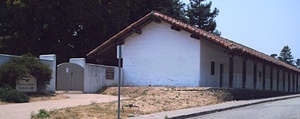| Location |
| 130 Emmet Street on Mission Plaza directly off Mission Street on Mission Hill |
| Hours |
| Thursday thru Sunday 10am-4pm |
| Phone |
| (831) 425-5849 |
| Web |
| http://www.parks.ca.gov/?page_id=548 |
| Established |
| Founded August 28th, 1791 |
Overview
The Santa Cruz Mission is one of a series of California missions that were established between 1769 and 1823 as military and religious outposts by the Spanish Crown. For many people, the establishment of the missions is thought of as as one of the main contributing factors to the genocide of Native Americans in California. History of the Native Americans has often been overlooked, and people often associate the mission with its architecture, which is representative of a California style, as opposed to its genocidal history.
The founding of the missions was established through the brutal enslavement of the Native Americans living in California at the time. Spanish soldiers rounded people up, and members of different tribes/cultural groups were relocated around the state. Once they were interned by the Spanish, they were not allowed to leave, and they were forced by the Friars to build the missions.
The rate of population decline among Native Americans at Mission Santa Cruz was approximately 90-95% per generation, and life expectancy locally at mission Santa Cruz averaged 8.6 years.1
At the Santa Cruz Mission, Native Americans were given new names, and they weren't allowed to speak their own languages or practice their own religions. Hunting and gathering was also prohibited unless it was to supplement the mission's needs during hard times.
Native Americans at the Santa Cruz Mission were disciplined with whippings, stockades, irons, incarceration, beatings, exile to distant missions, and executions.
According to Philip Laverty, 90% of the crimes punished at the Santa Cruz Mission amounted to resistance. On December 14, 1793, the Santa Cruz mission was attacked and set on fire after some baptized Quirostes were forced back into internment. Padre Andrés Quintana was killed there in 1812 after he began using a whip with metal wire at the end of each strap. Native Americans rebelled against their enslavement at other California missions, as well, and in one uprising they burned most of the buildings at Mission La Purísima in Santa Ynez.
History
Mission Santa Cruz (formal name:"Mision la Exaltacion de la Santa Cruz) was founded on August 28th, 1791, by Father Fermin Lasuen. It was the twelfth mission to be built in the California mission system. The original mission location was on the lowlands near the San Lorenzo River, near where River Street runs today. The mission flooded during its first winter and was relocated to higher ground. The second mission complex (at the current mission location) began construction in 1793. For an excellent account of mission building construction history, see "Construction Chronology of the Site of Holy Cross Church: Ex-Mission Santa Cruz became Holy Cross", by Edna E. Kimbro (available on-line at http://www.santacruzpl.org/history/articles/25/).
The mission's decline began in 1796 when Alta California Governor Diego Borica established the Branciforte pueblo just across the river. Although Spanish law forbade the establishment of a pueblo within a league of a mission, Borica expected the mission to support the pueblo. The first pueblo colonists included criminals sent from San Blas in Baja California and former Spanish soldiers, and soon the mission residents began to feel the ill effects of the pueblo— encroachment on mission lands, theft of livestock, and abuse of the natives. Within 2 years of the pueblos establishment, over 200 natives had fled from the mission and the local population declined. The padres at the mission needed individuals to replace the missing natives, and recruited the Yokuts from the San Joaquin valley and others by force.
Additionally, in 1818, Argentinian pirate Hippolyte de Bouchard was sited on the coast and the rest of the missionaries and natives fled to safety at Mission Santa Clara. However, the residents of the Branciforte pueblo took this opportunity to loot and steal what they could. Then, in 1834, the mission was secularized. These events left the mission struggling to stay in operation.
Today
A complex of buildings stands on the site of the original Santa Cruz Mission, including the present Holy Cross Church. There is also a half-scale replica of the original adobe mission church (pictured at right), and a reliquary (to the left of the mission replica in the photo) containing some surviving mission relics. The only remaining original mission building is the adobe dormitory that Indian families built and lived in while they worked at the mission. This building (also known locally as the "School Street Adobe") and its site are now a state park. Its seven rooms (out of an original 17) house a museum that shows the changes that occurred in the native people's lives when they came to the mission.
References & Citations
- 1Mission Santa Cruz and the Ohlone and Yokuts Indians, by Philip Laverty, retrieved on May 12, 2012.
- The dark, terrible secret of California's missions, by Elias Castillo, SFgate, November 8, 2004, retrieved on May 12, 2012.
Related Links
- Wikipedia Article: Mission Santa Cruz
- Wikipedia Article: Mission Indians
- Wikipedia Article: Spanish Missions in California
- Native Americans
- Ohlone
- Santa Cruz City History
- Parks and Open Spaces
- Lost Towns
Comments
2011-05-29 11:26:30 What was the livestock??? What were the crops???! —173.51.49.207




